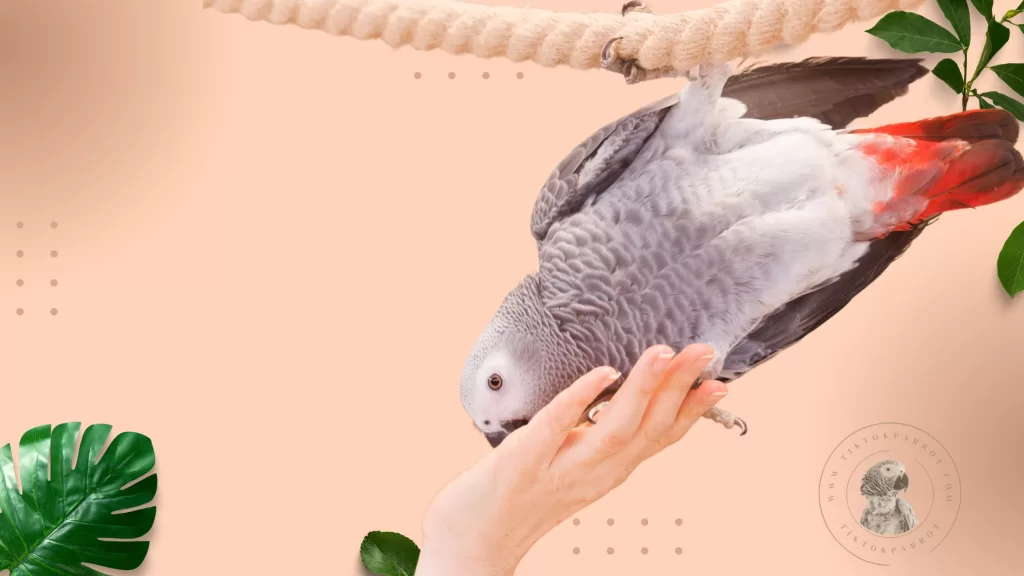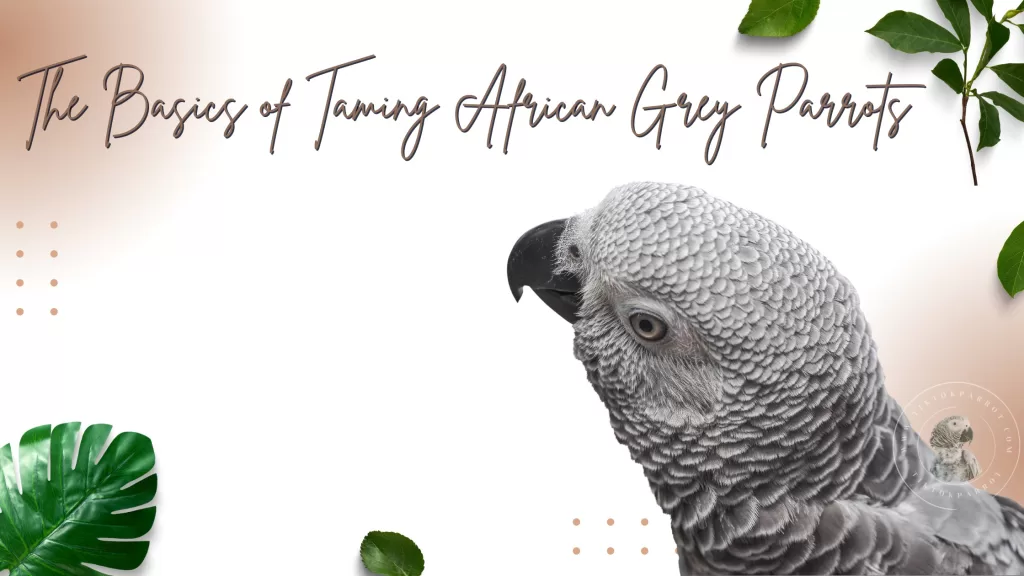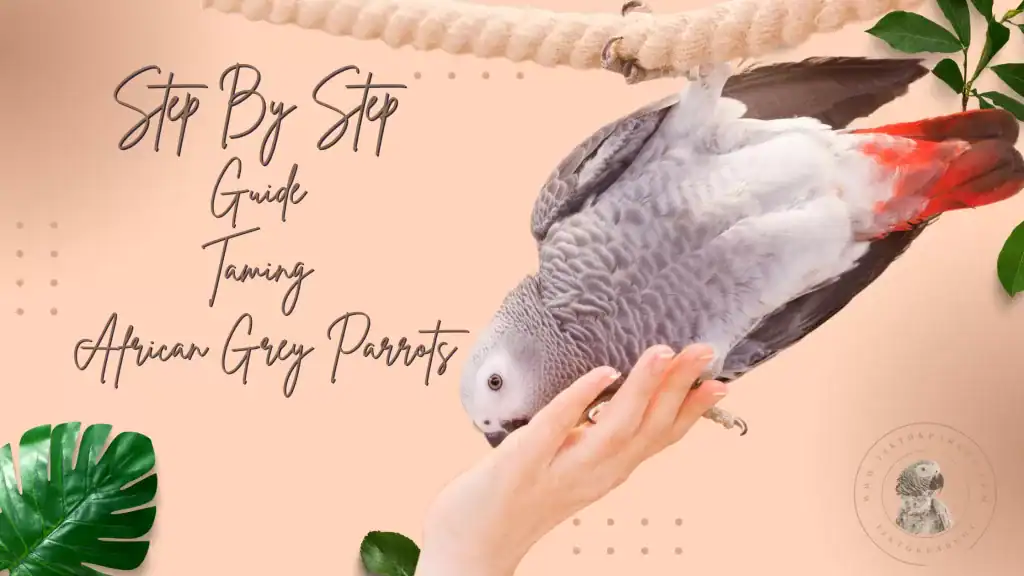Ah, the African Grey Parrot – a magnificent creature known for its unparalleled intelligence and remarkable speaking abilities. If you’ve recently welcomed one of these beauties into your life or are considering doing so, you’re likely wondering how to tame African grey parrots and build a bond that will last a lifetime.
Well, you’ve come to the right place! In this guide, we’ll take you through the essential steps to help you create a strong connection with your feathered friend. So, without further ado, let’s dive into the world of taming African grey parrots.
Discover how to tame African Grey Parrots with our comprehensive guide, featuring expert tips, step-by-step instructions, and FAQs to ensure your parrot becomes a beloved companion.
The Basics of Taming African Grey Parrots
African greys can also be challenging pets to handle, especially for inexperienced owners. Taming a grey parrot requires patience, consistency, and dedication. In this article, we’ll discuss how to master the art of taming an African grey.
Understanding Their Unique Personality
Before embarking on your journey to tame your grey parrot, it’s crucial to understand their distinct personality traits. These parrots are known for their:
- Intelligence: They’re capable of learning a vast array of words and phrases, solving complex puzzles, and displaying problem-solving skills.
- Sensitivity: African greys can be quite sensitive to changes in their environment, and they require a calm, stable atmosphere to thrive.
- Shyness: These birds can be initially shy around new people, but with patience and proper taming techniques, they’ll warm up to you.
African greys are social birds that require a lot of attention and interaction with their owners. They can become bored and destructive if left alone for too long. Additionally, greys have a tendency to become “one-person” birds and bond strongly with their favorite person. This can make it challenging for other family members to interact with the bird.
Creating a Comfortable Environment
A cozy, safe living space is essential for taming your African grey. To create a welcoming environment, make sure to:
- Provide a spacious cage with perches, toys, and a clean environment.
- Position the cage in a quiet, low-traffic area of your home, away from direct sunlight and drafts.
- Establish a daily routine for feeding, playtime, and sleep.
Step-By-Step Guide to Taming African Grey Parrots
In this step-by-step guide, we’ll explore the key elements of taming an African grey and how to build a strong bond with your feathered friend.
Step 1: Build Trust Through Observation
Initially, give your parrot some space to observe you without feeling threatened. Spend time near their cage without direct interaction, allowing them to become accustomed to your presence.
Building trust is the first step in taming the parrot. It’s important to let the bird become accustomed to your presence and voice before attempting to handle them. Spend time near the cage talking to your parrot in a calm and reassuring tone. Offer your bird treats and toys to help build positive associations with you.
Step 2: Offer Treats and Positive Reinforcement
As your African grey becomes more comfortable with you, begin offering treats through the cage bars. This will help them associate your presence with positive experiences.
Positive reinforcement is key to taming an African grey. Reward your bird with treats, praise, and attention when they exhibit good behavior. This will help to reinforce positive behaviors and encourage your bird to continue to interact with you.
Step 3: Gradually Introduce Touch
Once your parrot is comfortable taking treats from you, slowly introduce touch by gently stroking their beak or head through the cage bars. Always be patient and gentle, and never force contact.
Taming a parrot is a slow and steady process. Start by offering your bird treats from your hand through the cage bars. Once the bird is comfortable taking treats from your hand, you can move on to offering treats while your hand is inside the cage. Gradually work up to touching the bird and offering scratches. It’s important to move at the bird’s pace and not rush the process.
Step 4: Encourage Step-Up Training
Teach your African grey to step onto your hand or a handheld perch by gently pressing against their chest and offering verbal encouragement. Reward successful attempts with treats and praise.
Proper training is essential for taming an African grey parrot. Enroll in a bird training class or work with a professional bird trainer to learn the proper techniques for handling and training your parrot. This will help you to build a strong bond with your bird and ensure that they are happy and healthy.
Step 5: Establish a Routine and Socialize
Develop a daily routine that includes regular handling and socialization with other family members, while maintaining a calm and stable environment to continue building trust.
Consistency is critical when taming an African grey. Make sure to spend time with your bird every day, even if it’s just for a few minutes. Stick to a regular routine and provide plenty of mental and physical stimulation to keep your bird happy and engaged.
Step 6: Patience
Patience is the most important aspect of taming a parrot. African greys are intelligent birds, but they can also be stubborn and independent. Don’t get frustrated if progress seems slow or if your bird regresses in their behavior. Consistency and patience will pay off in the end.
Frequently Asked Questions (FAQs)
Are African greys easy to tame?
African greys are considered moderately easy to tame, particularly when socialized from a young age. However, their intelligence and sensitivity require consistent, patient training to develop a strong bond and ensure proper behavior.
How do you tame an African grey bird?
Taming an African grey bird involves building trust through gentle, consistent interaction, using positive reinforcement to reward desired behaviors, and providing a safe, stimulating environment. Socialization and patience are key factors in developing a strong bond with your African grey.
How can I get my African GREY parrot to trust me?
To gain your African grey parrot’s trust, approach them calmly, spend quality time together, and use positive reinforcement like treats and praise for desired behaviors. Consistency and patience are vital in building a secure bond and fostering mutual trust.
How do I get my African GREY parrot to stop biting?
To discourage biting in your African grey parrot, establish trust through positive reinforcement, provide mental stimulation, and redirect unwanted behavior. Consistency, patience, and understanding their body language are crucial for building a strong bond and curbing aggressive tendencies.
How do you discipline a bird for biting?
Discipline a bird for biting by using gentle redirection or calmly placing them back in their cage for a brief time-out. Avoid shouting or physical punishment, as this may exacerbate aggression. Consistency, positive reinforcement, and understanding the underlying cause of biting are key in addressing the issue.
How long does it take to tame an African Grey Parrot?
Taming an African Grey Parrot can take anywhere from a few weeks to several months, depending on the bird’s individual personality and history. Patience, consistency, and positive reinforcement are key.
Why is my African grey attacking me?
Your African grey may be attacking you due to fear, territorial behavior, or hormonal changes. Identifying the cause, respecting their boundaries, and maintaining a consistent routine can help alleviate aggressive tendencies and improve your relationship with your parrot.
Can older African Grey Parrots be tamed?
Yes, older African Grey Parrots can be tamed, although it may take longer than with younger birds. Consistent, gentle interaction and patience are essential in building trust with an older parrot.
How to tame an older vicious African grey?
Taming an older, aggressive African grey requires patience, consistent positive reinforcement, and slowly building trust. Start by establishing a routine, offering treats from a safe distance, and gradually increasing interaction while respecting the bird’s boundaries and comfort level.
What type of treats should I use for positive reinforcement?
Offer your African Grey healthy treats like small pieces of fruit, vegetables, or nuts. Make sure to choose treats that your parrot enjoys and reserve them exclusively for training and bonding sessions.
How can I keep my African Grey Parrot mentally stimulated during the taming process?
Provide your parrot with various toys, puzzles, and foraging activities to keep their mind engaged. Rotate toys regularly to maintain their interest, and consider introducing new challenges as they become more comfortable with you.
Can I train my African Grey Parrot to talk while taming them?
Yes, as you bond with your parrot, you can begin teaching them to talk by repeating words and phrases regularly. Make sure to use positive reinforcement and practice patience, as some birds take longer to learn than others.
How do I handle my African Grey Parrot’s potential fear of hands?
To help your parrot overcome any fear of hands, practice slow, gentle movements, and avoid sudden or aggressive gestures. Use treats and positive reinforcement to create positive associations with your hands.
How do I deal with an African Grey Parrot that bites during the taming process?
If your parrot bites, it’s essential to remain calm and not react aggressively. Instead, calmly and gently place the bird back in their cage, allowing them time to settle down. Practice patience and consistency in your training, and avoid reinforcing biting behavior with attention.
Is it necessary to clip my African Grey Parrot’s wings during the taming process?
Clipping your parrot’s wings is a personal decision, but it can help prevent escape attempts and encourage dependence on you during the early stages of taming. Consult with an avian veterinarian before making this decision, and consider your parrot’s safety and well-being.
How much time should I spend daily with my African Grey Parrot for successful taming?
Ideally, spend at least 1-2 hours per day interacting with your African Grey Parrot during the taming process. This will help establish trust, familiarity, and a strong bond.
How can I tell if my African Grey Parrot is stressed during the taming process?
Signs of stress in African Grey Parrots may include excessive vocalizations, feather plucking, loss of appetite, or aggressive behavior. If you notice these signs, reassess your taming techniques and consider giving your parrot more space and time to adjust.
Should I cover my African Grey Parrot’s cage at night during the taming process?
Covering your parrot’s cage at night can help create a sense of security and establish a routine. However, it’s essential to monitor your parrot’s response, as some may feel more stressed with a covered cage. Adjust your approach based on your parrot’s individual needs.
Can I use clicker training to help tame my African Grey Parrot?
Yes, clicker training is an effective method for taming and training African grey parrots. The clicker helps provide consistent, immediate feedback, allowing your parrot to quickly associate desired behaviors with positive reinforcement.
How much attention do African Greys need?
African greys need a significant amount of attention, ideally several hours per day, to maintain their emotional well-being and prevent boredom. Providing mental stimulation, social interaction, and consistent routines helps support their overall health and happiness.
How can I tell if my African Grey Parrot is becoming comfortable with me?
Signs that your African Grey is becoming more comfortable with you include:
- Relaxed body language: A content parrot will have a relaxed posture, with their feathers slightly fluffed.
- Curiosity: If your African Grey starts to approach you voluntarily, it shows they are growing more at ease in your presence.
- Vocalizations: Happy, chatty sounds are a good indicator that your parrot is feeling comfortable around you.
Are there any common mistakes to avoid when taming African Grey Parrots?
To ensure success in taming your African Grey Parrot, be mindful of these common mistakes:
- Rushing the process: Forcing interaction before your parrot is ready can lead to fear and mistrust.
- Inconsistent routines: Maintaining a consistent daily routine is crucial for establishing trust and reducing stress.
- Inadequate socialization: Make sure to gradually introduce your parrot to various people, sights, and sounds to help them become well-adjusted and confident.
How do I know if my African grey is happy?
A happy African grey will display behaviors such as vocalizing, playing with toys, exploring their environment, and interacting positively with you. Additionally, a relaxed posture, healthy appetite, and regular preening are indicators of a content and well-adjusted parrot.
How do you calm a scared parrot?
To calm a scared parrot, approach them slowly and speak softly, offering gentle reassurance. Create a safe and quiet environment, and provide familiar toys or treats to help them feel more at ease. Patience and understanding are crucial in helping your parrot overcome fear and anxiety.
Do African grey parrots like to be petted?
African grey parrots may enjoy being petted, particularly around their head and neck, once they establish trust with their owner. However, individual preferences can vary, so it’s important to observe your parrot’s body language and reactions to ensure they are comfortable with the interaction.
Why won’t my parrot let me touch him?
Your parrot may not let you touch them due to fear, lack of trust, or discomfort with physical contact. Building a strong bond through positive reinforcement, respecting their boundaries, and gradually introducing touch can help your parrot feel more comfortable with interaction. Patience and understanding are essential in fostering a trusting relationship with your parrot.
What stresses parrots?
Parrots can become stressed by a variety of factors, including changes in routine or environment, lack of social interaction or stimulation, exposure to loud or sudden noises, and health issues. Poor nutrition, inadequate sleep, and improper care can also contribute to stress and anxiety in parrots.
My Final Thoughts
I would say taming an African Grey Parrot requires patience, consistency, and dedication. Understanding your bird’s behavior and characteristics, building trust, positive reinforcement, and proper training are all essential for success.
Learning how to tame African Grey Parrots is an incredibly rewarding experience. By understanding their unique personality traits, creating a comfortable environment, and following our step-by-step guide, you’ll be well on your way to forging a bond that will last a lifetime.
Remember again, patience and consistency are crucial – take your time, enjoy the journey, and you’ll soon have a loving, intelligent companion by your side.
If you found this blog helpful, It would be great if you could share it with your family and friends who might find it useful as well.
You might like to read these as well 🙂
Understanding of Grey Parrot’s Body Language
The Surprising Benefits of Owning an African Grey Parrot
Is Your African Grey a Jealous Bird? Here’s What You Need to Know!
African Grey Parrot Male or Female? (Determine Gender of African Grey)
The Mesmerizing Eyes of African Grey Parrot & What They Can Tell
African Grey Parrots: The Ultimate Guide to Care and Training
Unlock the Secrets of Choosing the Perfect African Grey Parrot
The Importance of a Cage for Your African Grey Parrot
The Battle of the Birds: African Grey Parrot vs Macaw
Winning Parrot Names: How to Choose a Name That Strengthens Your Bond
The Secret Life of African Grey Parrots: What You Need to Know Before Owning One
For more useful content about African grey parrots, you can subscribe my site with your email to get notification upon publishing a new blog, the subscribe box you can see on the right side of this page. Also if you get an alert on your web browser while browsing my site, allow it and that will also give you an alert whenever I publish a new blog. 🙂
Stay safe and much love !


If you are interested in supporting me, kindly consider utilizing my affiliate link for your Amazon purchases. Your support would be greatly appreciated.














